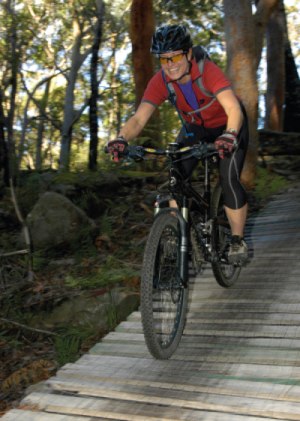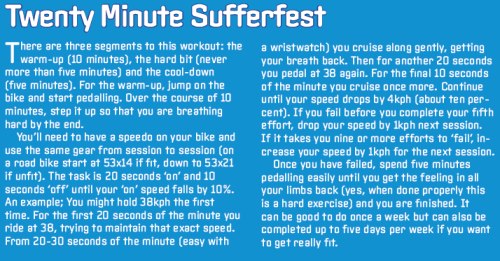Fitness Fast
Life can be pretty overwhelming at times, especially when you have your plate full with work and family commitments. As a result, riding often takes a back seat and fitness wanes. When a ride opportunity finally presents itself, you’re left as a wheezing gasping mess, flailing away behind your fitter riding buddies. This article will look at some small things you can do to keep your body prepared for cycling with only a small investment of time.
Commute to Work
I once lived about 16km from work. I would leave at the same time in the morning as another (driving) occupant in the house, headed to roughly the same destination. In the morning traffic, I usually didn’t get overtaken by his car until 1-2km from work. So I was getting in two decent rides per day in the same time as driving would have taken. Many cities have bike racks on the bus system now. This allows you to take the bus part of the way depending on the weather and how you feel. Some days you might ride the whole way, while other days your only riding will be from home to closest bus stop. I coach a guy who uses his car for work, so on Monday he drives in with his bike in the boot. Then he can ride most days through the week, riding home for the night and back the next morning leaving his car in secure parking. Sometimes you need to be creative but there is usually a solution that will allow you to commute by bike, thereby increasing your time on the bike and not having to find extra hours in the day.

Use a Trainer
Indoor trainers are ideal for time strapped people as they provide a concentrated workout with no distractions, no traffic lights to stop at or descents to coast down. One friend of mine had no time to ride, as much of his free time was taken up by looking after his two children. Once they were old enough to allow him an uninterrupted hour on a regular basis, he started a training program entirely indoors. Another busy guy that I coach has an exercise bike set up in his office and he gets in two to three workouts a week in slow periods without even leaving the building. You may be able to do something like this too. Even if you only get 20 minutes free, it’s enough time to complete a significant workout (see the ‘Twenty-Minute Sufferfest’).
Stretching
I recommend stretching to all cyclists (actually all people), whether riding daily as a professional or intermittently for pleasure. The benefits spread through your whole life, from relief of lower back pain to sleeping better at night. Regular stretching, such as in a once a week lunchtime class, assists the sporadic cyclist by keeping muscles supple and balanced which in turn helps to prevent pain or injury after a bike ride. Taking this a step further, you’ll gain flexibility and core strength from yoga. Look for a yoga class in your local area, even half an hour once a week should offer benefits (but one hour twice a week is ideal). Alternately, get a DVD such as ‘Yoga for Cyclists’ (www. bagear.com.au) and do your yoga at home. You can also get these benefits from enrolling in a Pilates class if yoga doesn’t work for you.
Spin Class
Many cyclists I know spend their winters in spin classes with good results. There are lots of names for this activity, depending on the brand your local fitness centre offers but they are quite similar in that you have a room full of people pedalling a bike with a heavy flywheel to the beat of loud music while a person up front leads you through a tough aerobic workout. Most spin classes pack a high quality cycling specific workout into a 45 minute time slot.

Running
Running is tough. It uses more muscles than cycling and there’s no place to hide. You’ll be working hard whether it’s flat, uphill or down—there’s no wheel sucking or downhill coasting! As a result, a quick half hour run twice a week can really help to maintain or lift your aerobic fitness. While running fitness doesn’t translate 100% directly to cycling, it can improve your general body conditioning and will certainly keep you fit. Running also involves impact with the ground, which will maintain or increase your bone density. The real beauty of running is that you can do it almost anywhere at any time—all you need is some shorts and a pair of joggers. But be warned, poor technique and taking on too much too soon will quickly lead to injury. Middle-aged cyclist with no running history will probably have a hard time and I generally steer them away from it. If you want to have a go, ensure that you ease your way into it over several months and seek advice on correct technique and injury prevention—www. coolrunning.com.au is a good place to start. If your body is up to it, a couple of short runs per week might be the perfect way to up your overall fitness for mountain biking with a minimal time investment.
Diversify
There’s any number of aerobically taxing sports that can enhance your overall body fitness and may be easier or more convenient to cram into a lunchbreak at work—squash, swimming, rollerblading, whatever takes your fancy. Build regular exercise into your schedule as suggested above, or perhaps you can think of a different way that works better for you. The single most important part is to start. Once you make it happen for six weeks in a row, it will be on its way to becoming a habit. Then, when you do get a chance to get on the dirt with your mates, you’ll have more fun. And fun is the bottom line!




